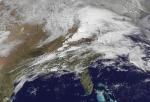“Extension on the Go” podcast by Debbie Johnson. Episode 63: March/April Weather
COLUMBIA, Mo. –While much of Missouri was drought-free at the end of March, other parts are still in moderate to severe hydrological drought, said Pat Guinan, climatologist for the University of Missouri Extension Commercial Agriculture Program.
“When you look at regions of Missouri, there are still some very dry parts of the state. In particular, northwestern Missouri,” Guinan said. “It’s imperative that we do get some decent precipitation events over the next several weeks for this region in order to bring surface water supplies to capacity and restore soil moisture.”
Missouri has seen several significant precipitation events since the end of January, but the northwestern corner of the state missed out on them, Guinan said. “Climatologically, the winter season is the driest season up in northwest Missouri, and the 2012-13 winter season acted accordingly.”
This means that the northwestern corner of the state is going into spring with a notable moisture deficit. “We still have resources that are running well below normal, both above and below the ground,” he said.
In addition, Guinan says, some of Missouri’s western-tier counties are still in a moderate to severe hydrological drought conditions, according to the U.S. Drought Monitor, a joint effort of the USDA, the National Weather Service, the National Drought Mitigation Center and others.
If spring cooperates, there could be some relief for the parts of Missouri that missed this year’s rain and snow.
“Now that we’re in April, there will be a greater opportunity to put a dent in drought conditions in northwest and western parts of the state,” Guinan said. “Normal spring (March-May) precipitation across northwestern sections ranges from 10 to 11 inches, compared to normal winter (December-February) totals that range from 3 to 4 inches.”
According to the National Weather Service’s Climate Prediction Center seasonal outlook, there’s an enhanced likelihood of above-normal precipitation for the April through June period for most of Missouri, Guinan added.
Guinan said a severe drought one year doesn’t make a drought the following year more likely with respect to the weather patterns that set up.
“For example, in 1980 we had extreme summer drought and high temperatures,” he said. “Then the growing season in 1981 turned out to be one of the wettest on record.”
Read more http://extension.missouri.edu/news/DisplayStory.aspx?N=1800





